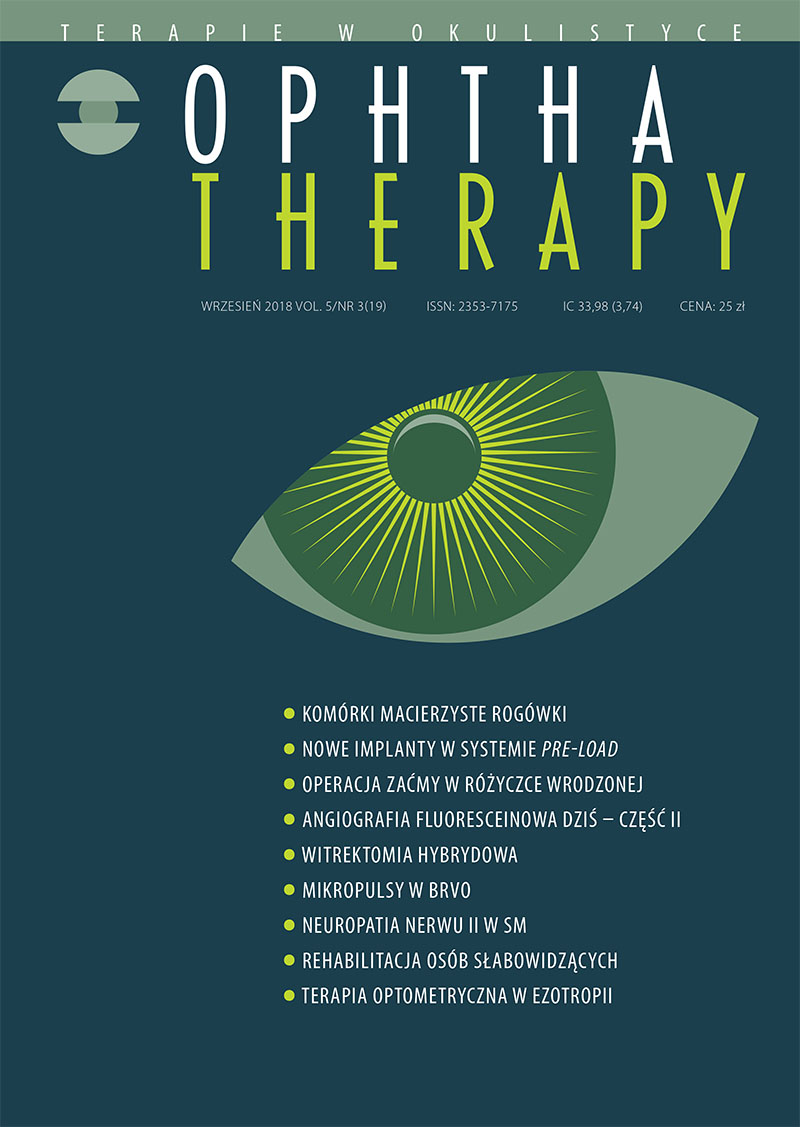The efficiency of optometric vision therapy in accommodative esotropia with high AC/A ratio
Main Article Content
Abstract
Convergence excess esotropia is commonly treated with corrective glasses (plus lenses), which reduces the angle of deviation for a distance, but the near deviation is still observed. Two types of approach are used to manage convergence excess esotropia: bifocals or eye muscles surgery. Nevertheless, both treatments seem to fail to influence the stereovision. The paper describes the case of 10-year-old girl, diagnosed with convergence excess esotropia with high AC/A ratio, who was subjected to the optometric vision therapy and bifocals. As an effect, visual parameters were improved, and majority of visual symptoms decreased. This case indicates that treatment plan for esotropia should include improvement of accommodation, eye movements and inter-ocular suppression, what strongly influence oculo-motor control and stereovision.
Downloads
Article Details

This work is licensed under a Creative Commons Attribution-NonCommercial-NoDerivatives 4.0 International License.
Copyright: © Medical Education sp. z o.o. License allowing third parties to copy and redistribute the material in any medium or format and to remix, transform, and build upon the material, provided the original work is properly cited and states its license.
Address reprint requests to: Medical Education, Marcin Kuźma (marcin.kuzma@mededu.pl)
References
2. Sefi-Yurdakul N, Kaykisiz H, Koc F. The effects of partial and full correction of refractive errors on sensorial and motor outcomes in children with refractive accommodative esotropia. Int Ophthalmol. 2018 [Epub ahead of print].
3. Uretmen O, Kose S, Oztas Z et al. Factors influencing stereoacuity in refractive accommodative esotropia. Can J Ophthalmol. 2007; 42: 600-4.
4. Lambert SR, Lynn M, Sramek J et al. Clinical features predictive of successfully weaning from spectacles those children with accommodative esotropia. J AAPOS. 2003; 7: 7-13.
5. Lee HJ, Kim SJ, Yu YS. Stereopsis in patients with refractive accommodative esotropia. J AAPOS. 2017; 21: 190-5.
6. Tejedor J, Gutierrez-Carmona FJ. Amblyopia in High Accommodative Convergence/Accommodation Ratio Accommodative Esotropia. Influence of Bifocals on Treatment Outcome. Am J Ophthalmol. 2018; 191: 124-8.
7. Pratt-Johnson JA, Tillson G. Sensory outcome with nonsurgical management of esotropia with convergence excess (a high accommodative convergence/accommodation ratio). Can J Ophthalmol. 1984; 19: 220-3.
8. Whitman MC, MacNeill K, Hunter DG. Bifocals Fail to Improve Stereopsis Outcomes in High AC/A Accommodative Esotropia. Ophthalmology. 2016; 123: 69096.
9. Somer D, Cinar FG, Oral B et al. Combined recession and resection surgery in the management of convergence excess esotropia with different levels of AC/A ratio. J AAPOS. 2017; 21: 7e1-7.
10. West CE, Repka MX. A comparison of surgical techniques for the treatment of acquired esotropia with increased accommodative convergence/accommodation ratio. J Pediatr Ophthalmol Strabismus. 1994; 31: 232-7.
11. Millicent M, Peterseim W, Buckley EG. Medial rectus fadenoperation for esotropia only at near fixation. J AAPOS. 1997; 1: 129-33.
12. Akar S, Gokyigit B, Sayin N et al. Medial rectus Faden operations with or without recession for partially accommodative esotropia associated with a high accommodative convergence to accommodation ratio. Br J Ophthalmol. 2013; 97: 83-7.
13. Arnoldi K, Shainberg M. High AC/A ET: Bifocals? Surgery? Or Nothing at All? Am Orthopt J. 2005; 55: 62-75.
14. Vivian AJ, Lyons CJ, Burke J. Controversy in the management of convergence excess esotropia. Br J Ophthalmol. 2002; 86: 923-9.
15. Griffin JR, Grisham JD. Binocular Anomalies: Diagnosis And Vision Therapy. Butterworth-Heinemann, Boston 2002.
16. Ciuffreda KJ, Rumpf D. Contrast and accommodation in amblyopia. Vision Res. 1985; 25: 1445-57.
17. Manh V, Chen AM, Tarczy-Hornoch K et al. Accommodative performance of children with unilateral amblyopia. Invest Ophthalmol Vis Sci. 2015; 56: 1193-207.
18. Singh V, Agrawal S. Visual functions in amblyopia as determinants of response to treatment. J Pediatr Ophthalmol Strabismus. 2013; 50: 348-54.
19. Toor S, Horwood AM, Riddell P. Asymmetrical accommodation in hyperopic anisometropic amblyopia. Br J Ophthalmol. 2018; 102: 772-8.
20. Nawrot P, Michalak KP, Przekoracka-Krawczyk A. Does home-based vision therapy affect symptoms in young adults with convergence insufficiency? Optica Applicata. 2013; 43(3): 551-66. https://doi.org/10.5277/oa130314.
21. Caloroso EE, Rouse MW, Cotter S. Clinical Management of Strabismus. Butterworth-Heinemann, Boston 1993.
22. Przekoracka-Krawczyk A, Michalski A, Wojtczak-Kwaśniewska M. Visual Therapy in Open Space Rehabilitation of Acquired Visual Field Defect. Neuropsychiatry (London). 2018; 8(5): 1527-32. https://doi.org/ 10.4172/Neuropsychiatry.1000487.
23. Wilson ME, Bluestein EC, Parks MM. Binocularity in accommodative esotropia. J Pediatr Ophthalmol Strabismus. 1993; 30: 233-36.

